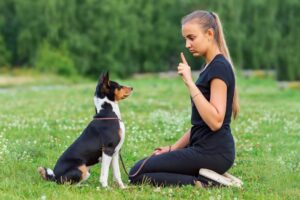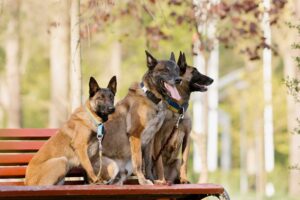






I’ve been thinking a lot lately about the silent signals between a handler and their protection dog. You know, those unspoken exchanges that say more than words ever could. Recently, I attended a small social gathering at a friend’s place. One of the guests brought along her Rottweiler—a well-trained protection dog.
As expected, everyone was in awe of the dog, admiring her from a distance while nervously trying to gauge whether it was safe to approach. You could see the hesitation in their faces, their hands hovering awkwardly as they debated whether to pet her or maintain a respectful distance.
What intrigued me most, though, was how the dog navigated the room. While the humans chattered away, caught up in their conversations, the Rottweiler silently drifted to the quieter corners of the apartment, away from the crowd.
At first glance, you might dismiss her movements as insignificant, but when you observe closely, every action is purposeful. At that moment, I realized just how much was communicated without a single command from her handler.
It got me thinking—how often do we overlook these subtle, non-verbal cues in the relationship between a handler and their protection dog?
What most people don’t realize is that protection dogs aren’t just trained to follow commands; they’re trained to be in constant, silent communication with their handlers.
A private language–one that both handler and dog learn to master over time. To an outsider, it’s invisible, maybe even impossible to detect. But for those who know what to look for, it’s crystal clear—an entire conversation happening in silence.
Here’s the thing: protection dogs are naturally observant creatures.
From the moment a protection dog enters a room, they are scanning their surroundings, subtly responding to the handler’s body language, posture, and even emotional state.
And I’m not talking about flashy commands or exaggerated gestures. Nah, it’s the little things—a shift in weight, a glance, or a slight movement of the hand, or even changes in scent due to stress or anxiety—that guide the dog’s actions.
While this may seem like intuition, there’s a lot of science behind how dogs pick up on human cues.
Studies have shown that dogs are capable of interpreting human emotions through subtle changes in our body language and tone of voice. They can sense when we are tense or relaxed, happy or anxious—and they respond accordingly.
In the case of a protection dog, this heightened sensitivity is paired with intense training. The handler’s role is to channel that natural awareness and create a system of signals that allows for seamless communication.
A simple tilt of the head might mean “stay alert,” while a relaxed posture could tell the dog to stand down. These signals are as much about conveying emotion as they are about giving commands.
With well-trained protection dogs, words are often unnecessary—they interpret the world through movement.
Dr. Patricia McConnell, in her influential work “The Other End of the Leash,” captures this essence perfectly: “All dogs are brilliant at perceiving the slightest movement that we make, and they assume that each tiny movement has meaning.”
For well-trained protection dogs, this natural ability elevates to an art form. Every subtle shift, every twitch of a muscle, is processed and decoded in real-time, creating a silent language that is both instinctive and highly refined.
Now, let’s break down some of the key non-verbal cues handlers use and what they really mean.

A simple palm turned outward might signal the dog to stay put, while a quick motion of the fingers can direct the dog to come forward or change position.
To the untrained eye, it’s almost imperceptible. But for the dog, these gestures are as loud and clear as any verbal command. Handlers spend hours fine-tuning these cues during training so that they become second nature.
The beauty of it? These gestures can be executed without breaking the handler’s stride or raising suspicion, which is crucial when operating in public or unpredictable environments.
The handler’s body speaks volumes, often without them even realizing it. Protection dogs are finely attuned to their handler’s stance and orientation.
A slight lean forward? That might be the signal for the dog to go on high alert, preparing for potential action. A relaxed, casual posture? It’s a silent cue that everything is fine, and the dog can stand down.
Body positioning is particularly important in crowded or noisy environments where verbal communication isn’t practical.
A handler may guide their dog with nothing more than the way they position themselves in relation to a doorway, a person, or a potential threat
Ever had a moment where someone gave you a look and you instantly knew what they were thinking? That same dynamic exists between handlers and their protection dogs.
Eye contact is one of the most powerful tools in non-verbal communication. A quick glance from the handler might tell the dog to stay alert, while prolonged eye contact could mean, “We’re okay here.”
But it’s not just about the eyes. Dogs are incredibly perceptive when it comes to facial expressions.
Even the smallest change—a raised eyebrow, a tightened jaw, or a hint of a smile—can convey approval, caution, or a need for immediate action.
Dogs are masters at picking up on the energy and tension levels of their handlers. They don’t need words to sense when something’s off.
A handler’s emotional state—whether calm, stressed or somewhere in between—sends a direct signal to the dog. This connection is so strong that a handler’s mood can instantly change the dog’s behavior.
A spike in tension—whether it’s from anxiety, excitement, or concern—puts the dog on high alert, ready to protect or defend.
On the flip side, when the handler is calm and collected, the dog feels safe to relax too. Handlers are trained to remain composed, knowing that their dog will take its cues from them.
Protection dogs respond to their handlers’ cues with their own set of non-verbal signals.
Here are the most important cues:

A high tail that’s gently wagging signals confidence, while a tail straight out shows the dog is on high alert. however, if the tail’s tucked, that’s a sign of fear or discomfort.
When a protection dog stands tall, weight evenly distributed, you’re looking at a confident animal.
But a more cautious or defensive posture—lowered stance, muscles tense—tells you the dog is ready to spring into action. It’s their way of saying, “I’m ready for whatever comes next.
Just like humans, dogs express a lot with their faces. A soft, relaxed expression means all is well, but when their face tenses up—eyes narrowing, mouth tightening—that’s a signal they’re on guard.
While we’re talking non-verbal, it’s worth mentioning how a dog’s voice plays into this. Growls, whines, or even a sudden change in breathing can signal something important.
These sounds are often cues to a handler that the dog senses something, and you’d be wise to pay attention.
If you’re working with a protection dog—or thinking about it—developing that silent bond is everything.
Here are a few practical ways to enhance that unspoken understanding:
Take some time to simply watch your dog in different environments. Notice how they move, how they react, and what their body language tells you. The more you tune in, the better you’ll understand their natural cues and how they communicate with you.
Start adding hand gestures, facial expressions, or even slight shifts in body movement into your daily training. Over time, your dog will begin to recognize these subtle signals and respond without needing verbal instructions.
Your energy sets the tone. Dogs are incredibly intuitive and will pick up on your emotional state. If you remain calm and consistent, your dog will follow suit. Make sure you’re using the same non-verbal signals each time so your dog knows exactly what you expect.
Dogs respond best to clear cues and immediate rewards. Establish a reward system, like a click or a treat, to reinforce positive behavior.
At first, treats are helpful, but eventually, your dog will associate the hand signal itself with the desired action. A pat, a kind word, or even just eye contact can become the reward once the signal is mastered.
But, I’d recommend…
By now, it’s clear that silent signals between a protection dog and their handler transcend mere verbal commands.
It’s a partnership rooted in trust, intuition, and a silent understanding that’s rare to find. Well-trained protection dogs don’t just guard—they anticipate, adapt, and stay by your side, always attuned to your needs, and always ready.
At Vanguard Protection Dogs, we’ve made it our mission to nurture this unique bond from day one. Our expert training ensures that you and your dog develop a seamless partnership where they read every subtle signal and respond with precision.
But don’t just take my word for it—reach out to Vanguard Protection Dogs and experience how our expertly trained dogs can bring unmatched security into your life.